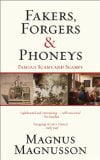 Fakers, Forgers and Phoneys: Famous Scams and Scamps
Fakers, Forgers and Phoneys: Famous Scams and Scamps
by Magnus Magnusson
Mainstream, £9.99, ISBN 978-1-84596-210-4
I must begin by admitting that the author of this book, who died in January 2007, was a friend of mine. However, if he weren’t I would still say it’s an excellent and fascinating work. There are four sections, on art forgeries (Keating, van Meegeren, the Cottingley fairies); archaeological frauds (Piltdown Man, the Vinland Map); impostors and hoaxers (the Tichborne claimant, George Psalmanazar); and literary forgeries (Thomas Chatterton, William Henry Ireland).
A constant theme is how easy it is to fool people, even experts: Magnus begins, somewhat inevitably perhaps, with the story of The Emperor’s New Clothes. Van Meegeren, facing imprisonment or even death for selling a ‘Vermeer’ to Goering, said he had painted it himself and was, of course, disbelieved by the experts who had authenticated it until he painted another before their very eyes. The Cottingley fairies were a joke by two girls that got out of hand: after Conan Doyle fell for it, the perpetrators felt they had to carry on rather than reveal that such a famous and distinguished man had been fooled.
Some of the most interesting stories are those told more briefly than as the subjects of complete chapters, such as: the woman who claimed to be Anastasia; the Hitler diaries; Dr James Barry, the woman who masqueraded as a man and had a successful career as a naval doctor, which might be understandable if she had been big with a deep voice, but she was small and slight with a high voice; the Kensington Stone, allegedly found in Minnesota (the most Nordic state in the USA) and apparently showing that Vikings penetrated that far, but in fact an obvious fake, its ‘runic’ inscriptions being a bizarre mix of modern Swedish, Norwegian, Danish and English; and Nat Tate, a nonexistent artist about whom a book was published with great fanfare, no-one daring to admit never having heard of him. As Magnus says: “The fact is that credulous people can be persuaded to believe anything; there seems no end to people’s gullibility, no matter how crude the forgeries might be.” A good read, and a fitting epitaph to a splendid man.
Ray Ward

